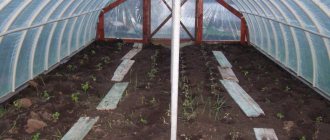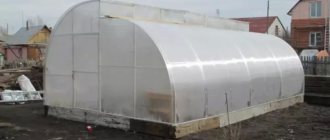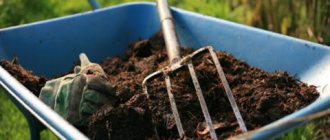Autumn is not only a time of great joy due to the end of the summer season, the harvest, a wonderful summer, but also the beginning of the next stage in caring for your favorite vegetable garden. Simply collecting all the garbage and dead tops is not all the necessary procedures that a gardener who loves his garden needs to do.
Particular attention should be paid to the greenhouse. This is one of those places where in summer comfortable conditions are created for the growth and development of not only plants, but also all kinds of bacteria and microorganisms. It is also very important to properly prepare the greenhouse for wintering, so that it (especially if it is made of polycarbonate) overwinters well and is ready for planting work in the spring.
Greenhouse in autumn: cleaning, fertilizers, general care
Why do you need to clean your greenhouse in the fall?
Old-time gardeners will say that they never washed or treated the greenhouse and everything grew perfectly. But already in August they were picking the last cucumbers, because the bushes had turned yellow, blackened, and the fruits were rotting. Autumn - you might say. Diseases - experienced gardeners will say.
Preparing a greenhouse in the fall for the next season is necessary in order to:
- get rid of spores of fungal diseases and bacteria;
- destroy insect larvae and bugs that eat plants;
- treat the soil, bring it to the optimal pH;
- enrich the soil in the greenhouse with organic matter and micro-macroelements.
Tillage
In case of severe contamination of the soil by pests, it is removed (layer from 7 to 10 centimeters). Further reuse of this soil for growing another crop is prohibited. The soil is taken outside the site and disinfected. New soil is poured in place of unsuitable soil. If the infection was moderate, then it can be treated with chemical additives. The soil is not dug up before disinfection from bacteria. Preliminary digging is necessary only when treating against harmful insects, since they can hide deep underground. When digging, it is best to treat the soil with copper sulfate to avoid the appearance of fungal diseases.
When to clean and wash the greenhouse
The processing time for polycarbonate greenhouses in the fall will be different for each region. It depends on the first frost, plant diseases, and harvesting. If late blight or another parasitic disease is raging in the greenhouse, which is no longer controlled by safe biological products, then you can safely end the season and not torment yourself or the plants.
But, basically, the harvesting dates are determined at the end of September - beginning of October, later in the southern regions. Even if the weather is favorable for the harvest to ripen, it is still worth processing. Because beneficial bacteria, which are added to the soil to decompose organic matter, work in the heat.
Turn off the electricity and remove the sensors
If your greenhouse has a light or electric heating system, temperature and humidity sensors installed, then everything must be de-energized for the winter. Changes in temperature and humidity during the off-season can damage expensive equipment, so all sensors must be removed and stored in a dry, heated room.
Features of a polycarbonate greenhouse
There were no processing problems with film greenhouses: at the end of the season, summer residents got rid of the film, and the soil was treated as open ground. In the case of polycarbonate greenhouses, the treatment is slightly different.
Firstly, if the frame is metal or galvanized, then the greenhouse cannot be treated with a sulfur bomb, iron sulfate and Farmayod. When these substances come into contact with iron, corrosion will occur. With an aluminum structure, it’s possible.
If you are not sure what the frame is made of, try it on a small piece of the structure before working on the entire greenhouse.
Secondly , always start processing from the soil. If you first wash the walls and then start working on the soil, then spores of fungi and bacteria with dust can get on the polycarbonate and remain over the winter, and in the spring, accordingly, they will start attacking plants.
Thirdly , soil cultivation in closed ground is different: the rate of preparations is doubled. Those. Prepare all consumable medications in double concentration. We will talk about how to treat a polycarbonate greenhouse in the fall later in the article.
Fertilize the soil
The autumn stage of soil preparation also includes the application of fertilizers. Over the summer, the soil has been greatly depleted; it needs new nutrients so that next spring and the coming summer the plants receive them in sufficient quantities.
Experienced summer residents advise that in the autumn it is necessary to add organic fertilizers to the soil. This could be compost, peat, humus, manure. Many people are afraid to add the last source of organic matter to the soil, but in the fall this can be done safely - the plants are no longer growing in the greenhouse, which means that the manure will not harm anyone.
Table of manure composition for fertilizing greenhouse soil
Step 1. Dig the soil thoroughly.
The soil in the greenhouse is being dug up
How to prepare manure for fertilizer yourself
Step 2. Distribute manure over its surface at the rate of 10-20 kg per m2 and dig again.
Manure for fertilizer
Manure is evenly distributed over the soil surface
The soil needs to be dug up again
Step 3. Sprinkle everything with regular ash.
Sprinkle everything with ash
Step 4: Cover with clean grass.
Step 5. After snow falls, cover the entire surface of the soil with it. The layer of white “blanket” should be about 20 cm. In spring, this measure will allow the soil to immediately be saturated with the necessary moisture.
Snow in the greenhouse
Attention! Manure and humus can themselves become a source of weed seeds getting into the soil. Be prepared for this.
By the way, snow will help equalize the temperature in the greenhouse and in the open space, which is important to ensure the safety of the structure during the winter. And the soil will freeze less during the cold months.
Processing a polycarbonate greenhouse in the fall
Let's start the autumn cleaning of the greenhouse. We explain step by step how and with what to clean the greenhouse after harvesting.
We remove all plant debris:
- we collect the remaining harvest;
- Carefully remove the above-ground part of the plant. Do not pull or shake! If it is sick, then carefully cut off the stem and take it out of the greenhouse for burning so that bacteria and fungus remain inside to a minimum;
- collect all weeds and fallen leaves;
- dig up the roots of the plants. Don't leave them in the ground. Remember that late blight spores overwinter on them. No roots - no late blight for next year.
Treating the soil
Always deal with the soil first and then the walls so that bacteria and fungal spores do not settle on the walls during the winter after digging in the dusty soil.
To cultivate the soil in closed ground, we spill one of the following preparations:
- Trichocin, 2 times with an interval of 14 days;
- Fitolavin, once;
- Copper sulfate;
- Inta-Vir;
- Farmayod (in soil only).
We use all drugs according to the instructions, but in double concentration. For example, we dilute Trichocin at 6 grams. for 10 liters, and 12 g. for the same 10 liters. This is an effective treatment for late blight, whitefly and mites in a polycarbonate greenhouse in the fall.
The best option for treating the soil in a greenhouse would be a complete or partial (15 cm) replacement of the soil. But few gardeners can do this every year.
We treat the walls of the greenhouse with preparations, and then wash it
If it seems to you that it does not need washing, then simply treat it. But often after the season, the walls of the greenhouse turn yellow due to the color of the cucumber leaves, which grow high and adhere to the polycarbonate. You can wash it with either a mop or a garden hose.
How to treat polycarbonate greenhouse walls in the fall:
- tar soap;
- tobacco checker;
- alcohol + chlorhexidine (expensive method, but works)
The following drugs kill all living things in the greenhouse, so they are effective, but you can get corrosion of the metal parts of the greenhouse:
- Farmayod;
- Sulfur checker;
- Iron sulfate solution.
Biological preparations such as EM-Bio, Baikal-EM1, Serebromedin also work in treating polycarbonate greenhouse walls, but the solution must be prepared in double concentration.
We increase soil fertility in the greenhouse after processing and washing the walls
How to fertilize the soil in a greenhouse in the fall? We add one by one:
- Organics : manure, compost or humus at the rate of 8 kg per 1 sq. m, add grass, annuals and everything that is on the compost site.
- Mineral fertilizers : phosphorus, potassium, calcium, magnesium. Any one labeled “Autumn” or separate mixtures of the same name, such as Potassium Monophosphate and dolomite flour (calcium), will do. Calcium is a must for those whose greenhouses suffered from blossom end rot. In the case of separate fertilizers, do not apply dolomite flour and magnesium sulfate together. They give a harmful chemical reaction. You will bring one of them in in the spring.
- live bacteria to all soil amendments to process organic matter and make the soil saturated. We water the greenhouse with the biological preparation EM-Bio, Baikal-EM1 or Serebromedin. Make the solution stronger - double the size, so that the bacteria have time to work before the cold weather begins. But bacteria only work at temperatures above 8 degrees. Therefore, we close the doors and windows in the greenhouse and create a “bathhouse”. Some gardeners even install heaters to help little workers process all the organic matter.
- The final step in preparation will be planting green manure in the greenhouse. An optional item, but green manure is: - leafy organic matter; - protection from pests (mustard, phacelia); - nitrogen supplement; - soil loosening; - compliance with crop rotation: after them, the same plants can be planted in the same place. We grow green manure until 10-15 cm and embedded in the ground.
- And one more thing that is good for the soil: as soon as enough snow falls, throw it inside the greenhouse. This will protect the soil from complete dehydration and deep freezing, and will also help soil bacteria wake up faster in the spring.
Disinfection
Disinfection can be carried out in various ways and is necessary to cope with rot, late blight and other scourges dangerous to garden crops. One of the simplest and most popular methods is to fumigate the structure from the inside using a sulfur bomb. It is sold in almost any gardening store. If you don’t have it, you can buy regular sulfur (consumption 80 g per m2).
Sulfur smoke bomb Climate
Prices for sulfur smoke bomb
sulfur smoke bomb
Step 1. Take a metal sheet or any strong container or stand and place the sulfur in it.
Sulfur bombs require sturdy stands
Step 2. Set fire to the prepared substance.
Lighting the fuse
Step 3. Quickly exit the greenhouse and close all doors tightly behind you. The sulfur burns for about an hour - all this time, watch the process in order to keep the situation under control if something happens.
Fumigation of a greenhouse with a sulfur smoke bomb
Step 4. Do not enter the greenhouse for 2-3 days. Then ventilate it.
Ventilation of the greenhouse
Advice! Use a gas mask or at least a respirator and gloves when setting fire to sulfur in a greenhouse. In the event of an emergency, these simple personal protective equipment will keep you healthy. Sulfur is a very toxic substance.
Protective equipment: respirators, gloves, goggles
Sulfur is perfect for treating greenhouses against various pests and parasites. At the same time, even those pathogens that have settled in the soil are destroyed. But this substance can cause corrosion, so it is not entirely suitable for greenhouses with a metal frame.
Table. Products suitable for disinfecting greenhouses.
| Substance | Characteristic |
| Bleaching powder | Suitable for processing both soil and greenhouse frames, especially wooden ones. Dilute 400 g of the substance in 10 liters of warm water and let it brew for about 4 hours, stirring the liquid occasionally. Treat the soil with the resulting solution, spraying lime, and thoroughly coat the entire frame with the sediment. This treatment will allow the structure to last longer, and will ensure complete cleaning from pathogenic microorganisms. To disinfect, you can soak all garden tools in a lime solution. |
| Copper sulfate | Depending on the concentration, this substance can be used to treat both the soil and the greenhouse cover. To disinfect the coating, dilute 100 g of vitriol powder in 10 liters of water, preferably warm, and rinse glass, film or polycarbonate with this preparation. In order to shed the soil, dissolve 5 g of vitriol in a bucket of water. Liquid consumption is 2 liters per m2. |
| Bordeaux liquid | The best option for tillage. The composition is simple: dilute 100 g of vitriol in 5 liters of water, also dissolve 100 g of lime in another water, pour vitriol water into lime milk, mix everything. Bordeaux mixture is ready. It can also be used to treat the greenhouse structure itself. |
How to get rid of pest larvae in a greenhouse
Popular drugs against pathogenic microflora do not always save greenhouses from larvae. And in warm greenhouse soil there may be wireworms, larvae of the cockchafer (chafer), spider mites, etc. We tell you one secret on how to get rid of pest larvae in a greenhouse.
Find a drug called Metarizin in stores. The use of this beneficial fungus, which settles on the roots of plants and destroys pest larvae, will save you from everyone except mice. It does not cause any harm to the plants themselves. It is often used together with green manure.
But Metarizin only works at +12 and above, so in the autumn it is just suitable for greenhouses. During the winter, the fungus will fall asleep, and in the spring, if there are still green manure roots, it will wake up and begin to act again. It can be “run” for the entire season for pest prevention.
Rinse and dry the irrigation system
Frozen water can break pipes and connections, which means your sprinkler system, if you have one, needs to be dried out for the winter. However, before releasing air, clean and disinfect the pipes. This can be done using a solution of phosphoric acid or the drug Pekacid and its analogues. Fill the system with it and leave for 2-3 hours, then rinse under high pressure with clean water and dry.
If you have water barrels in your greenhouse during the summer, empty them, disinfect them with a similar product, and leave them empty for the winter. It is also recommended to remove and remove drip tapes from drip irrigation systems.
Conclusion
Caring for a greenhouse in the fall is not needed to leave it clean and disinfected into winter. This is necessary for the next season in order to minimize the spread of diseases and obtain a harvest for a long time. The more effort you put into your garden in the fall, the fewer problems you will have with the harvest next year. We told you step by step how and with what to treat a polycarbonate greenhouse in the fall to save you time searching for information. Choose any of the proposed drugs and take care of the future gardening season.
Remove top layer of soil
The soil may be infested with larvae and spores. Greenhouse conditions are favorable for the reproduction of surviving insects, and replacing the soil eliminates the problem of their appearance.
The procedure has a beneficial effect on soil fertility, especially if garden crops have been grown on it for several years.
It is necessary to replace the soil after processing the greenhouse so that the walls, other surfaces and soil are as clean as possible.
The top layer of soil (5-7 cm thick) is removed over the entire area of the greenhouse. It is irrational to completely change the soil. This is a labor-intensive process. The remaining microorganisms will be destroyed by winter frost. Additionally, you can carry out a disinfection procedure with vitriol in the spring.
The collected soil is taken to the compost heap. To replace it, lay a self-prepared soil mixture. It consists of sand, turf soil and peat. If earthen lumps have formed, it is not recommended to break them - with them the soil can withstand frost better.
What kind of soil do tomatoes like?
It is recommended to choose soil for tomatoes with the following properties:
- loose, not compacted, and therefore air- and water-permeable;
- quickly warms up;
- rich in nutrients (nitrogen, potassium, phosphorus) and mineral elements (calcium, magnesium);
- slightly acidic, that is, with a pH value of 5.5-6.5 (smaller numbers indicate an acidic reaction, and more than 7 indicate an alkaline reaction);
- not infected with pests and infectious diseases.
The following composition meets the listed requirements: peat - 60%, sand - 20%, compost - 20%.
Change or disinfect the soil
The soil of the greenhouse is actively exploited, accumulating the remains of fungicides, insecticides, fertilizers and salts. For this reason, for several years it becomes unsuitable for growing plants and turns into a breeding ground for diseases and pests. The best solution is to change the soil every 2-3 years. It is necessary to remove a layer 25-30 cm thick (on the bayonet of a shovel) and first remove the mulch, if any.
If it is impossible to replace the greenhouse soil, it will have to be revived. To begin, disinfect the soil with biological products that, in addition to suppressing microorganisms, heal the soil, for example Fitosporin-M, Fitotsid®-r, Baikal EM-5, Baktofit, Trichoderma Verid 471, etc. are applied to the ground two weeks before autumn frosts to a depth of 5-10 cm, the treatment can be repeated in the spring. Then add 40-50 kg of compost or rotted manure for each square meter and carry out a two-level deep digging. Then water the soil with preparations that accelerate the decomposition and humification of plant residues.
For those who aren't afraid to put in the extra effort, building hot compost beds in a greenhouse is a good option. To do this, a layer of fresh manure 15-25 cm thick, a layer of plant residues 25-30 cm thick, and at the end 20 cm of ready-made soil or compost are poured into the dug trenches. In autumn and early spring, the contents of the trenches will begin to decompose, and in the spring you will receive a ready-made warm ridge with fertile soil.
If you cleared the greenhouse from planting in early September, you can improve the soil with the help of green manure. Plant radishes, oats, mustard or other fast-growing, cold-tolerant green manures and before the worst cold weather, mow the green mass and work it into the soil.
Fertilize
It is worth adding not only organic matter to the soil in the fall, but also complex mineral fertilizers. If your greenhouse remains closed year-round and is not exposed to rain or snow, you can apply potash and phosphorus fertilizers as early as September and October. They will gradually dissolve in moist soil, but will not be washed away and will be available to plants in the spring. On average, 40-60 g of superphosphate and 25-30 g of potassium salt or potassium sulfate are added per 1 square meter of soil.
Preparing greenhouse structures for winter
All working tools must be disinfected
Having carried out all the cleaning work with the soil, you should immediately begin disinfecting and preparing the structure itself for the winter. Greenhouses with a film coating are partially or completely dismantled; glazed buildings, in addition to disinfection measures, need to be strengthened. It is worth considering in detail how to prepare greenhouses and various greenhouses for winter.
How to prepare a film-coated greenhouse for cold weather
Many summer residents install greenhouses on their property, with film stretched over the frame. This type of design is not very practical or convenient. After all, every fall you will have to dismantle it. There are subtleties in how to prepare a greenhouse for winter.
- First you need to wash the film coating from the inside with laundry soap, and then from the outside. Additionally, you can disinfect it with potassium permanganate diluted with water. It is important that the greenhouse film dries well. Then it is removed and, carefully folded, put away until the next season. If you leave the film coating outside in the cold, by spring it will become fragile and no longer suitable for use.
- It is important to process the frame after removing the film. This can be done using a bleach-lime solution. 400 grams of powder are diluted in a bucket of water and left to infuse for 3-5 hours, remembering to stir occasionally. The prepared solution is used to spray the soil and disinfect the tools, and the collected sediment is used to coat the greenhouse.
- When the cleaning is completed, the film covering is dismantled, all that remains is to coat the greenhouse arcs with a brush with kerosene.
Congratulations, the film-coated greenhouse is ready for wintering.
Preparing a glazed stationary greenhouse
Greenhouse windows are washed with soapy water and a soft cloth or sponge.
A glass greenhouse with a wooden or metal frame should be disinfected after harvesting and tilling the soil. During autumn work in the greenhouse, windows are washed with soapy water; aggressive detergents and hard brushes should not be used. When washing glass, it is important to pay attention to cleaning the gaps and small parts on the frames. Here pathogenic bacteria, fungi, and a whole family of pests can find a secluded place for wintering.
The wooden frame and frames should be washed with copper sulfate. Lime mortar can also be used for processing. When preparing a greenhouse for winter, metal parts and PVC structures are treated with boiling water mixed with vinegar.
Summer residents disinfect polycarbonate with potassium permanganate. All tools, pots, glasses and other items that were used in the greenhouse in the spring and summer are also subject to disinfection.











